25 Top Metaverse Statistics For 2024 (Users + Trends)

Are you in need of the latest metaverse statistics? Are you curious about the concept?
The metaverse is a virtual environment that allows us to interact with digital spaces in different ways. There are metaverse platforms, metaverse gamers and even metaverse real estate within those platforms.
In this post, we’ve rounded up the best metaverse statistics from around the web to help you understand this concept and its potential a little better.
Editor’s top picks – metaverse statistics
Here are our top five metaverse stats from this article:
- The metaverse will reach a market size of $29.26 billion in 2022. (Statista1)
- 74% of users are joining or want to join the metaverse. (Statista2)
- 45% of all adults in the United States are not familiar with the concept of the metaverse at all. (Statista3)
- Between virtual reality, augmented reality and mixed reality, VR has the highest market share at 48%. (Deloitte)
- Tracking and misuse of personal data are major concerns of the metaverse among 55% of users. (Statista10)
Key metaverse statistics
1. The global metaverse market size reached $29.26 billion in 2022
The collective extended reality market reached a global market size of $29.26 billion in 2022.
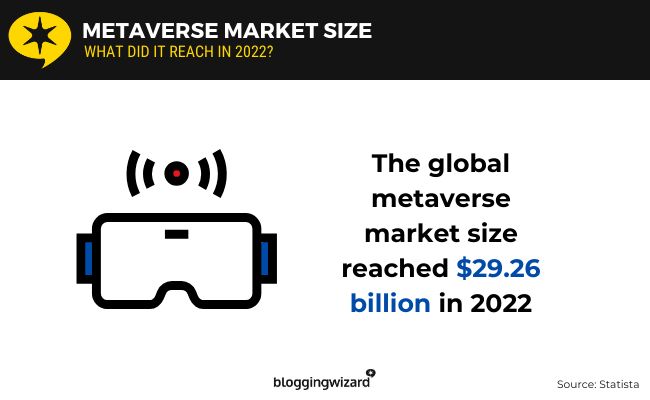
The market is expected to pass $100 billion by 2026.
Extended reality, or the metaverse, is comprised of virtual reality, augmented reality and mixed reality concepts.
Source: Statista1
2. The value of the metaverse could reach $5 trillion by 2030
According to future projections published in a report by McKinsey & Company, the value of the metaverse is expected to reach $5 trillion by 2030.
The market impact of the metaverse among the ecommerce industry is expected to fall somewhere between $2 and $2.6 trillion by 2030.
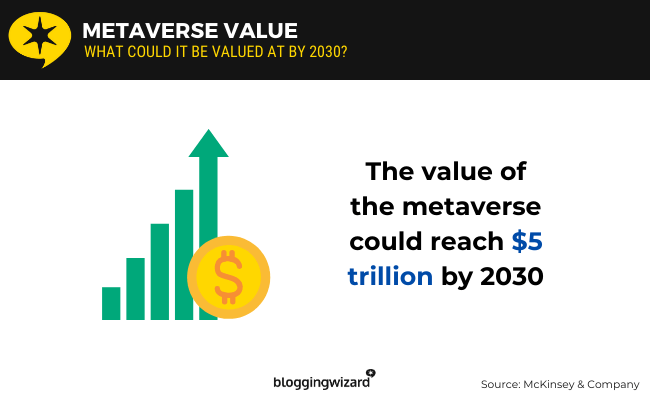
Estimates for market impacts for other industries are as follows:
- Academic virtual learning – The market impact of the metaverse for this industry will be $180 to $270 billion
- Advertising – $144 to $206 billion
- Gaming – $108 to $125 billion
Source: McKinsey & Company
3. 74% of internet users are considering joining the metaverse
According to a survey published by Statista, which had over 1,000 respondents, 74% of adults in the United States are joining or considering joining the metaverse.
As for why adults are considering joining, 41% want to experience things they aren’t able to in physical reality settings.
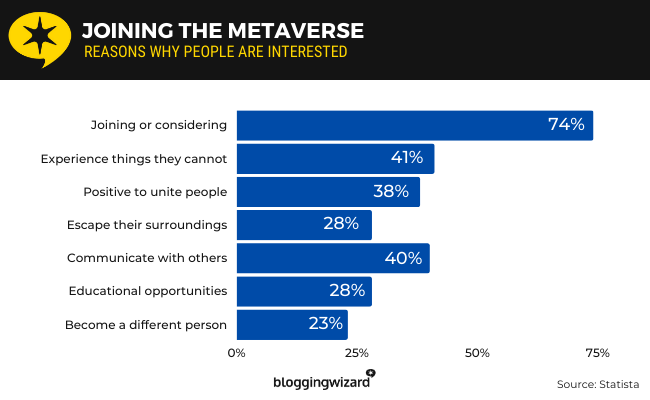
Here are other results:
- Want to communicate with others in the space – 40% of adults want to join the metaverse for this reason
- Think it could be a positive way to unite people – 38%
- Want to escape their physical surroundings – 28%
- Educational opportunities – 28%
- Want to become a difference person – 23%
Source: Statista2
4. 54% of experts believe the metaverse will be an important aspect of daily life for half a billion people by 2040
According to a survey by the Pew Research Center, only 54% of experts believe the metaverse will be a “much-more-refined and truly fully-immersive, well-functioning aspect of daily life for a half billion or more people globally.”

This means just under half of experts are not as confident about the metaverse’s influence in the long term.
Experts surveyed included technology innovators, developers, business and policy leaders, researchers, and activists.
Open-ended questions revealed common themes about what experts believe the metaverse will look like in the future, including a shared belief that augmented reality and mixed reality will take over virtual reality in popularity.
This means users will favor partial immersive experiences over fully-immersive ones.
Source: Pew Research Center
5. 45% of the general population in the United States is not familiar with the metaverse at all
According to a survey published by Statista, 45% of the general population in the United States isn’t familiar with the metaverse concept.
Respondents were asked to rate their familiarity with the metaverse on a scale from one to five with one being “not at all familiar” and five being “very familiar.”

Here are the results among the general population:
- 1 (Not at all familiar) – 45%
- 2 – 17%
- 3 (Neutral) – 19%
- 4 – 10%
- 5 (Very Familiar) – 9%
Adults aged 18 to 34 are the age group who are most familiar with the metaverse (16% are very familiar and only 23% are not at all familiar) while adults above the age of 55 are least familiar with this concept (64% are not at all familiar while only 1% are very familiar).
Source: Statista3
6. 66% of internet users think the metaverse has the potential to replace social media as we know it
Before we get into this stat, it’s important to note that survey respondents were also asked about their familiarity with the metaverse.
55% of respondents are reportedly not familiar with the concept at all.
However, of the 45% who are, 66% believe the metaverse has the potential to replace social media as we know it.
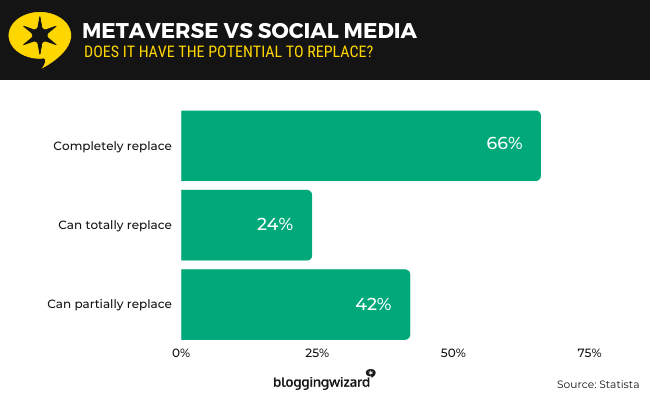
The survey even broke this statistic down: 42% believe the metaverse can partially replace social media while 24% believe it can replace it entirely.
Source: Statista4
7. Virtual reality has a 48% market share among all metaverse technologies
Deloitte’s report on the metaverse includes data on the market share for the different types of technology we use to create metaverse environments.
According to their data, virtual reality (VR) has a 48% market share.
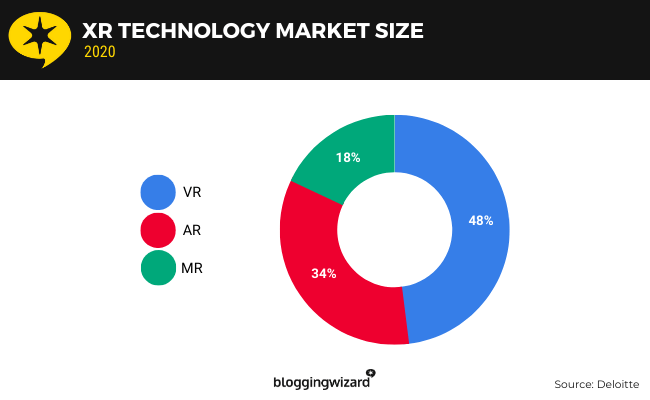
Augmented reality (AR) has a 34% market share while mixed reality (MR) has an 18% market share.
They’re all components under the umbrella terms “metaverse” and “extended reality (XR).” Here are brief explanations on how they differ from one another.
- Virtual Reality – A completely virtual environment you interact with in a way that makes it seem as though you’re actually in that environment. This is typically done through virtual reality headsets.
- Augmented Reality – A virtual environment that blends digital components with real-life environments. Pokémon GO is an example of this type of technology.
- Mixed Reality – A virtual environment in which digital and physical environments can interact. An application that allows you to create fully-furnished room designs for your home is a great example of this type of technology.
Source: Deloitte
8. 24% of consumers consider the cost of VR headsets to be very important when deciding to use the metaverse
This survey result comes from a survey published by Statista that had 4,420 respondents.
The survey revealed the cost of VR headsets to be the most important factor when adults consider whether or not to use the metaverse. 24% think low-priced VR headsets are “very important” when making this decision.
However, in spite of this statistic, it’s important to note that 36% don’t think low-priced VR headsets are important at all.
In fact, most respondents voted for the “not important at all” option for all considerations.
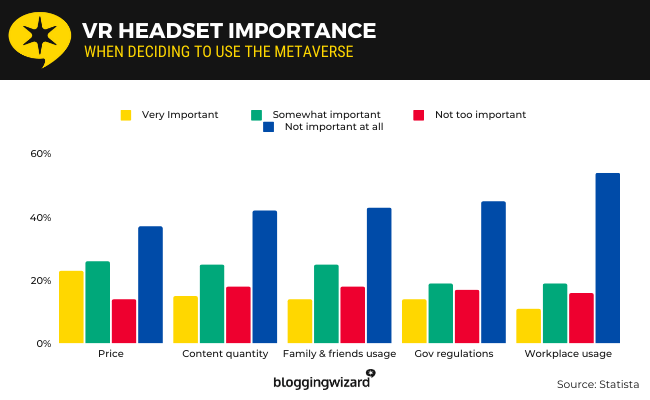
These are results when you only consider the survey’s “very important” responses:
- Large amounts of content – 15% think this is very important when deciding whether to use the metaverse
- Family and friends using it – 14%
- Government regulations – 14%
- Workplace using it – 11%
Source: Statista5
9. 59% of consumers expect brands to advertise in the metaverse through direct messages
A virtual universe gives users yet another way to use the internet and interact with the world, but like the internet we use today, it also gives marketers another way to advertise.
Internet users are ready for it. In fact, most expect it.
59% expect brands to advertise through direct messages while 52% believe brands will use pop-up ads.
Another 52% expect to be approached by sponsored or even employed influencers while in the metaverse.
Source: Statista6
10. 65% of marketers are open to working with metaverse influencers
Internet users are very familiar with the concept of influencers by this point in time. Influencer marketing has grown right alongside the emergence and growth of social media platforms.
Now that the Web 3.0, another term for the metaverse, is here, influencers have another way to grow their brands.
This is good because 65% of marketers are open to working with metaverse influencers while only 16% are not interested in expanding their marketing campaigns into the virtual world.
In contrast to that statistic, four out of 10 marketers would rather work with non-metaverse influencers.
Source: Statista7
11. 14% of internet users admit they would engage in hate speech in the metaverse but not in real life
According to a survey published by Statista, the results of which are from 1,050 respondents, 14% of internet users reportedly would engage in hate speech in a digital world but not in real life.
The survey revealed quite a lot about the differences in the way adults would behave in physical and digital worlds.

Here are other results from the survey:
- Try extreme sports like skydiving, bungee jumping or paragliding – 38%
- Alter my consciousness with the help of VR (instead of drugs and alcohol) – 27%
- Pretend to be someone else/create an alter ego of the opposite sex or different age or nationality – 24%
- Spend a lot of money on collectible clothes or accessories – 23%
- Try big game hunting – 22%
- Play adult games that engage in extreme violence and/or sex – 20%
- Watch virtual gladiators fight to death – 19%
- Conduct unethical experiments on virtual humans – 18%
- Watch virtual executions – 18%
- Own a virtual harem – 17%
Source: Statista8
Metaverse statistics on the public’s opinion on extended reality
12. 33% of adults are curious about the metaverse
In a survey published by Statista, adults were asked to rate their feelings toward the metaverse on a scale from “curious” to “confused.”
33% voted for curious while 12% voted for “confused.”

Here’s how users voted for other options:
- Uninterested – 27%
- Suspicious – 23%
- Concerned – 19%
- Indifferent – 19%
- Excited – 18%
- Optimistic – 16%
- None of these – 7%
Source: Statista9
13. 55% of consumers believe tracking and misuse of personal data to be a major problem among virtual worlds
According to survey results published by Statista, 55% of internet users in the United States voted “tracking and misuse of personal data” as being a major concern about the metaverse.
Aspects of the metaverse users are least concerned with include “motion sickness from VR headset,” which is not a concern for 41% of users, and “the environmental impact of energy consumption,” which is not a concern for 40% of users.

Other major concerns include:
- Online abuse and cyberbullying – Voted for by 44% of internet users as being a major concern
- Personal safety – 39%
- Sexual harassment – 38%
- Moderation of offensive or damaging behavior – 37%
- Impacts on mental health – 35%
- Motion sickness from VR headsets – 29%
- The environmental impact from energy consumption – 28%
Here’s how these concerns are listed when you list them from what users perceive as being “not a concern at all”:
- Motion sickness from VR headsets – 41% of internet users are not concerned with aspect of metaverse use
- The environmental impact from energy consumption – 40%
- Sexual harassment – 39%
- Impacts on mental health – 38%
- Moderation of offensive or damaging behavior – 34%
- Personal safety – 33%
- Online abuse and cyberbullying – 30%
- Tracking and misuse of personal data – 21%
Source: Statista10
14. 60% of internet users think suicide should be fully censored in the metaverse
In a survey published by Statista, internet users were asked about specific types of content and whether or not they should be censored in virtual worlds.
Suicide was at the top of the list when you arrange the data by what users think should be censored the most.
60% of users think this type of content should be censored while 29% think it should be restricted and 11% think it should be uncensored.
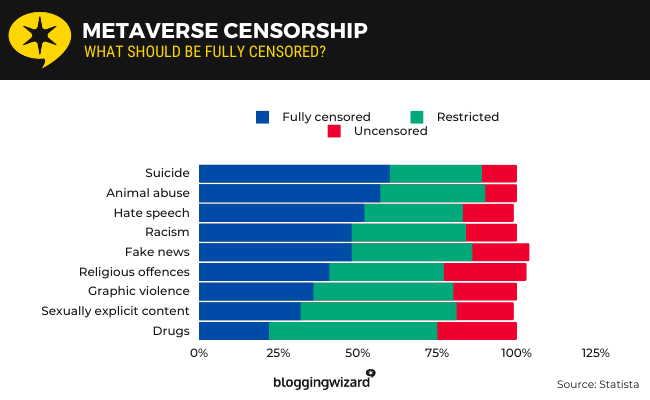
Here’s how users voted on other types of content:
- Animal Abuse
- Fully Censored – 57% of users think this content should be fully censored
- Restricted – 33% of users think this content should be restricted
- Uncensored – 10% of users think this content should be uncensored
- Hate speech and harassment
- Fully Censored – 52%
- Restricted – 31%
- Uncensored – 16%
- Racism
- Fully Censored – 48%
- Restricted – 36%
- Uncensored – 16%
- Fake news
- Fully Censored – 48%
- Restricted – 38%
- Uncensored – 18%
- Religious offenses and slurs
- Fully Censored – 41%
- Restricted – 36%
- Uncensored – 26%
- Graphic violence
- Fully Censored – 36%
- Restricted – 44%
- Uncensored – 20%
- Hate speech and harassment
- Fully Censored – 32%
- Restricted – 49%
- Uncensored – 18%
- Alcohol and drugs
- Fully Censored – 22%
- Restricted – 53%
- Uncensored – 25%
Source: Statista11
15. 47% of internet users believe addiction to digital worlds to be a danger among metaverse users
When surveyed about the potential dangers digital worlds will impose on its users, 47% voted “addiction to a simulated reality” as being the most dangerous.

41% believe privacy issues pose a threat while 41% are concerned about mental health issues.
Source: Statista12
Metaverse statistics on XR technology and metaverse trends
16. 110 million users will use AR environments at least once a month by the end of 2023
In 2020, 83.7 million internet users interacted with AR environments created by applications at least once a month.
That number is expected to reach 110 million users by the end of 2023.
Source: Statista13
17. Video games account for 33% of applications created for the metaverse
According to Deloitte’s report, business-to-consumer (B2C) video game applications make up the majority of applications that are created for metaverse environments.
The market share is 33%, to be exact.
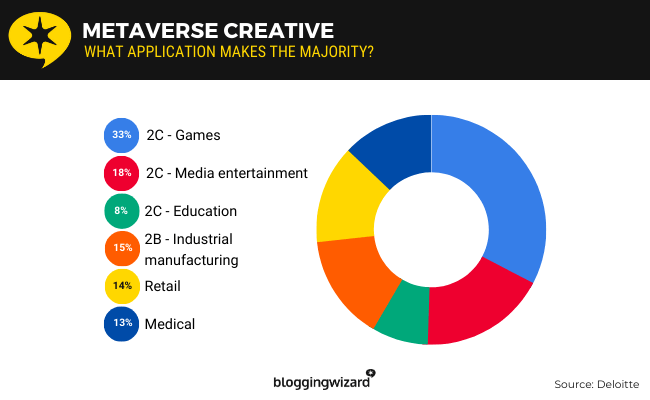
After that, we have B2C media entertainment apps with a market share of 18%, business-to-business (B2B) industrial manufacturing environments at 15%, B2B retail environments at 14%, B2B medical environments at 13% and B2C educational environments at 8%.
Source: Deloitte
18. $17.6 billion will be invested in improving entertainment-based applications for the metaverse in 2024
As metaverse revenue continues to grow, more and more companies are investing in this type of technology, specifically for the augmented and virtual reality concepts of the metaverse.
According to financial projections, $17.6 billion will be invested in VR gaming and video consumption and AR gaming.
In the business world, experts expect $4.1 billion to be invested into metaverse training and industrial maintenance use cases.
Source: Statista14
19. Estimated projections predict that 25% of consumers will spend at least one hour a day in the metaverse by 2026
Projections estimate that by 2026, 25% of consumers will spend at least one hour every day in the metaverse to engage in activities related to work, shopping, social interaction and entertainment.
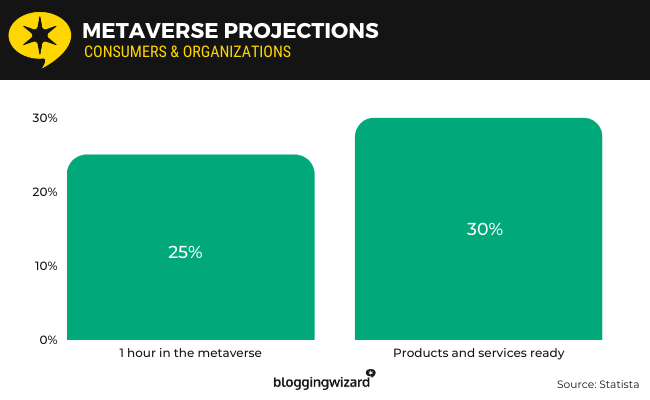
This is good because those same projections estimate that 30% of business organizations will have products and services made specifically for the metaverse by that time.
Source: Statista15
20. XR headset shipments will surpass 105 million by 2025
Extended reality headsets and advanced VR gear make it easier for metaverse users to interact in a virtual space.
2020 saw 7 million XR headset shipments, but experts believe that number to reach 105 million by 2025.
Source: Statista16
21. There will be 1.73 billion AR-capable user devices in the world by 2024
XR headsets are not the only way users can interact with the metaverse.
The devices we use on a daily basis are fully capable of allowing us to interact with AR environments. Again, Pokémon GO is an example of this.
By 2024, there will be 1.73 billion AR-capable user devices in the world.
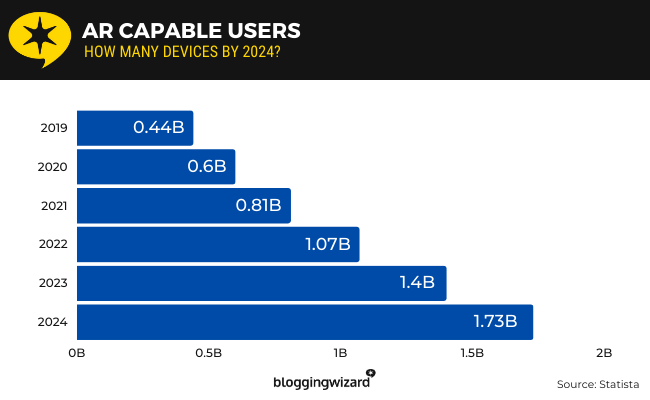
This is up from 0.44 billion in 2019.
Source: Statista17
22. $250 million is traded through NFTs on a daily basis
Virtual currency utilization is a part of the metaverse, and that includes NFTs, or non-fungible tokens.
An NFT is a unique digital identifier that can be used to verify ownership of digital art, music and more.
According to McKinsey & Company’s report, $250 million is traded through NFTs on a daily basis.
Source: McKinsey & Company
Statistics for metaverse projects and concepts
23. Roblox went public with a valuation of $41 billion
Roblox is a gaming platform and became one of the earliest metaverse projects when it launched in 2006.
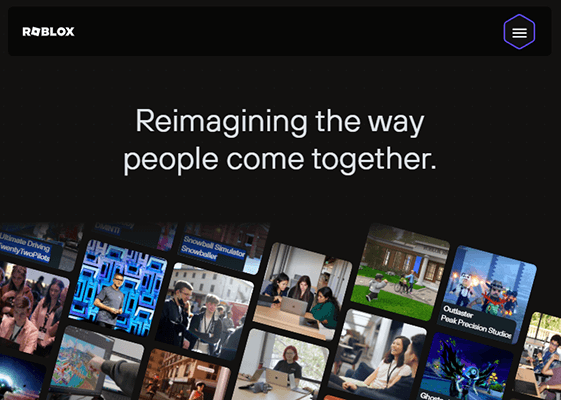
Its content is invested in the metaverse, making it a virtual platform where metaverse users can enter to play virtual games, attend social events, chat with other players, walk through virtual experiences and more.
The platform is marketed toward children and is primarily made up of user-generated content.
Its popularity took off in the 2010s, and when the company went public in 2021, it had a valuation of $41 billion or $64.50 per share.
In the article, Roblox CEO David Baszucki had been quoted as saying,
“We have a vision of the metaverse as a place where people come together to do things. And that could be having a virtual birthday party or that could mean studying ancient Roman history and going there with your friends… Even though you’re not able to be there together.”
Source: The Washington Post
24. 41% of adults are not interested in attending virtual concerts at all
According to a survey of 4,420 adults, 41% of adults in the United States are not interested in virtually attending live music events in the metaverse.
18% are very interested, 27% are somewhat interested and 14% are not very interested.

Millennials are most likely to attend virtual concerts in the metaverse as 29% reportedly are very interested and 32% are somewhat interested in this concept.
Baby boomers are least likely to attend virtual concerns as 61% are not interested in this concept at all.
Source: Statista18
25. Meta invests $10 billion into the metaverse on an annual basis
According to McKinsey & Company’s report, Meta, who owns Facebook and Instagram, is investing heavily into the metaverse.
The company is currently investing $10 billion into metaverse development applications annually.
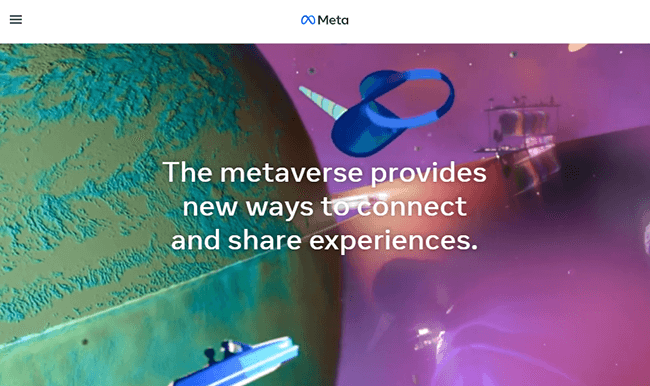
The transition of the company forming a parent company named “Meta” is a big part of this.
Source: McKinsey & Company
Sources
Final thoughts
That concludes our list of the best metaverse statistics.
We learned that although half of the general population are still unfamiliar with this concept, it has a lot of potential for future developments.
Along with entertainment purposes, companies are already investing in it as a way to provide consumers with digital shopping experiences and more effective ways to train employees.
Augmented reality and mixed reality technologies also provide a lot of potential in how companies are able to help consumers shop for goods and make final buying decisions.
Above all, the global metaverse market is only expected to grow.
If you’d like to check out more statistics, I’d recommend starting with these posts:
